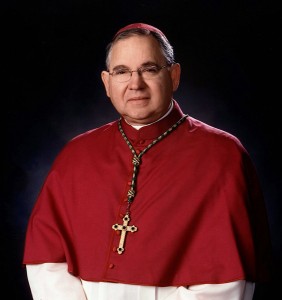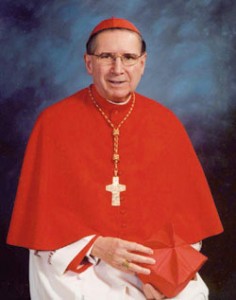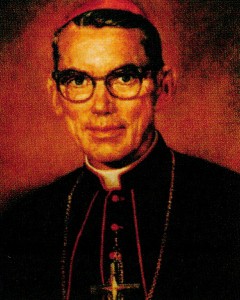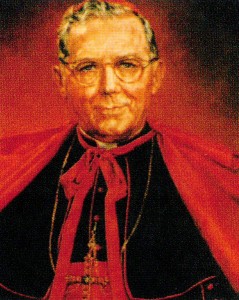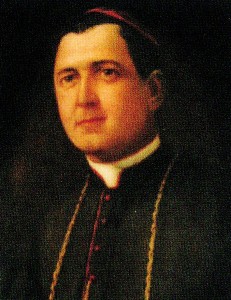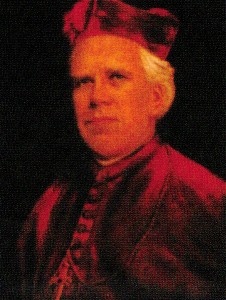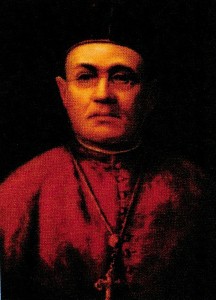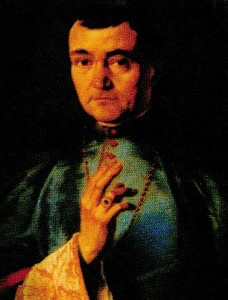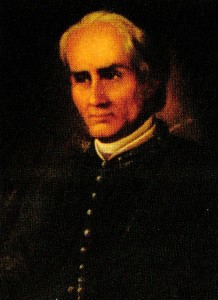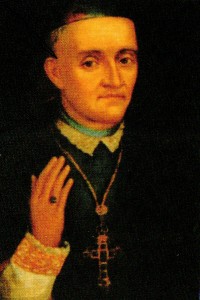Derived Primarily From The History of The Archdiocese of Los Angeles
Archbishop Jose H. Gomez
(2011 Onwards)
Archbishop Jose H. Gomez was born on December 26, 1951, in Monterrey, Mexico, to the late Dr. Jose H. and Esperanza (Velasco) Gomez, both deceased. He was the only boy among three older and one younger sister.
Ordained a priest of the Opus Dei Prelature on August 15, 1978, at the Shrine of Torreciudad, Spain, that same year Father Gomez earned the B.A. in Theology at the University of Navarre’s Rome Campus. He then began working on a Doctorate in Theology at its Main Campus in Pamplona, Spain, receiving his Doctorate in 1980.
Archbishop Gomez served as Archbishop of San Antonio from February 15, 2005 until April 6 2010, when he became co-adjutor with Right of Succession to Roger Cardinal Mahony; he succeeded his predecessor in the Archdiocese of Los Angeles on February 27, 2011. The Archbishop had previously served as Auxiliary Bishop of the Archdiocese of Denver, since his consecration as a bishop on March 26, 2001.
His Episcopal motto is taken from a scriptural passage of the Letter to the Hebrews: “Let us go forth with confidence to the Throne of Grace” (Heb. 4:16).
Before being appointed as an Auxiliary Bishop, Archbishop Gomez’s primary priestly duty was to minister to lay people. From 1987 to 1999 he was in residence at Our Lady of Grace Catholic Church in San Antonio, assisting in the pastoral work of the parish. During this same timeframe Archbishop Gomez also helped in the then Diocese of Galveston-Houston in Katy, Texas.
Archbishop Gomez has distinguished himself as a respected national leader among Hispanic priests in the United States. In 1991, became a Regional Representative of the National Association of Hispanic Priests (ANSH), an organization which seeks to strengthen fraternity among the over 2,400 Hispanic priests in the United States and to communicate the faith effectively among diverse Hispanic congregations. He was then named President in 1995 and Executive Director from 1999-2001.
From 1997 to 1998, Archbishop Gomez served as a member at large on the board of directors for the National Catholic Council of Hispanic Ministry (NCCHM), and then was treasurer in 1999. From 1998 to 2000, he was on the steering committee for Encuentro 2000, a national celebration of the Jubilee Year 2000, which took place in Los Angeles and was sponsored by the United States Conference of Catholic Bishops (USCCB).
Archbishop Gomez is also an enthusiastic supporter of vocations to the priesthood and religious life, and constantly encourages all Catholics to witness their faith in their daily lives. He serves on the Board of St. John Vianney Seminary in Denver, CO, was Chairman of the Board for Assumption Seminary in San Antonio, TX, and is now Chairman of the Board for St. John’s Seminary, Camarillo. He became is also a member of the Advisory Board of the National Conference of Diocesan Vocation Directors.
Archbishop Gomez spearheaded the establishment of Denver’s Centro San Juan Diego for Family and Pastoral Care, a place for formation of lay leaders and a base to provide welcoming services to immigrants.
Archbishop Gomez shows his loving and pastoral care for his flock.
While Auxiliary Bishop of Denver, he served as Rector of the Cathedral Basilica of the Immaculate Conception from 2001 to 2003. After that, he was named Moderator of the Curia and Vicar General for the Archdiocese of Denver and assigned as the Pastor of Mother of God Catholic Church, in Denver.
In 2005 he was named one of Time Magazine’s 25 most influential Hispanics in the United States, and in 2007 he was on a CNN’s list of “Notable Hispanics” in a web special celebrating “Hispanic Heritage Month”.
In 2006, Archbishop Gomez officially introduced The Catholic Community Foundation for the Roman Catholic Church of the Archdiocese of San Antonio, and established Hope for the Future, a fund that offers tuition assistance for Catholic schools in the Archdiocese.
In 2007, he was instrumental in bringing together Latino leaders and Bishops for the creation of the Catholic Association of Latino Leaders (C.A.L.L.). The Association’s purpose is to impact the national dialogue and to contribute to the mission of the Church, by identifying initiatives important to the building up of the Catholic community and supporting them in accordance with the Bishops’ directives.
On July 25, 2008 he was appointed by Pope Benedict XVI as a consultant to the Pontifical Commission for Latin America, whose purpose is to assist the human and spiritual needs of the Church in Latin America.
During 2008 and 2009 Archbishop Gomez served as the first chairman of the new Committee on Cultural Diversity in the Church of the USCCB, which was created to respond to the numerous and urgent needs of Church and society today, within the context of increasingly diverse cultures and races in our country.
In March of 2010 Archbishop Gomez participated in a solidarity visit to Haiti as Chairman of the USCCB Subcommittee on the Church in Latin America, to assess the needs and the support of the Church in the USA to the Church in Haiti.
On April 6, 2010, Archbishop José H. Gómez was appointed Coadjutor Archbishop of the Archdiocese of Los Angeles, California, by Pope Benedict XVI. The Archdiocese of Los Angeles is the largest Catholic diocese in the nation, with Hispanics comprising more than two-thirds of the archdiocese’s five million Catholics; 42 languages are spoken in 287 parishes. As coadjutor, Gómez automatically succeeded Roger Cardinal Mahony upon his retirement on February 27, 2011. He is the first Hispanic to serve as Archbishop of Los Angeles, as well as the highest-ranking Hispanic bishop in the United States. The Archbishop is a Knight Commander of the Order of the Holy Sepulchre, a Knight of Columbus, and a Knight of Peter Claver.
From the time he arrived in Los Angeles, the Archbishop began pursuing certain goals. Foremost among these were uniting his diverse flock in a sense of their commonality; pushing for immigration reform while awakening in Hispanic Catholics – particularly the new arrivals – a sense of their spiritual and civic responsibility to their new land; renewing among his flock a sense of their historical importance and current duty to their State and Nation; and revitalizing the seminary and expanding vocation. Nor has he been silent in the face of increasing pressure by the current administration in Washington on Catholic institutions. In pursuit of these goals he has made important speeches and written key documents. Even before coming to Los Angeles, he offered important advice to Hispanics in public life. At an address before the Napa Institute on July 28, 2011, in a pastoral letter on evangelization to the Archdiocese on October 2, 2012, in a homily on religious liberty for an Ecumenical Vespers in celebration of the Edict of Milan on December 2, 2013, and in his recent book Immigration and the Next America: Renewing the Heart of America, he has enunciated his vision.
The Queen of Angels Foundation welcomed Archbishop Gómez heartily; several board members attended the conferral of the pallium on him by Pope Benedict XVI on June 29, 2011 at the Vatican. He was present for the rosary at both the 2011 and 2012 Queen of Angels processions, and in 2013 marched with his flock from La Placita to the Cathedral, and offered the Mass there. We are proud to have him as our father in God.
Archbishop Gomez presently serves on the following boards and committees:
- Chair: Task Force on the Spanish Language Bible for the Church in America (USCCB), 2003 –
- Chair: Subcommittee on the Church in Latin America (USCCB), 2009 –
- Chair: Committee on Migration (USCCB), 2010 –
- Chair: Committee on Cultural Diversity in the Church (USCCB), 2008 – 2009
- Chair: Catholic Charities of Los Angeles
- Chair: Catholic Education Foundation of Los Angeles
- Synod Father: 13th Ordinary General Assembly of the Synod of Bishops on the New Evangelization, 2012
- Consultant: Pontifical Commission for Latin America, 2008 –
- Member: Pontifical Council for Social Communications, 2012-
- Member: Special Council for America, General Secretariat of the Synod of Bishops, 2010-
- Member: Committee on Doctrine (USCCB), 2003-
- Member: Subcommittee on Hispanics and the Liturgy (USCCB), 2005 –
- Member: Committee on Legislation and Public Policy (California Catholic Conference)
- Board Member: Catholic Legal Immigration Network, Inc.
- Board Member: ENDOW – Educating on the Nature and Dignity of Women
- Board Member: MATT – Mexicans and Americans Thinking Together
- Board Member: National Catholic Bioethics Center
- Board Member: Mexican American Catholic College
- Board Member: The Papal Foundation
- Episcopal Moderator: ANSH – National Association of Hispanic Priests
- Episcopal Moderator: National Catholic Network de Pastoral Juvenil Hispana
- Founding Member: Catholic Association of Latino Leaders (C.A.L.L.)
- Advisory Board Member: Napa Institute
Roger Cardinal Mahony
(1985 – 2011)
Catholics in California’s Southland rejoiced when word reached them that one of their own was returning to be the fourth Archbishop of Los Angeles. Their new prelate was the fourth native of Los Angeles and the twenty-third Californian called to the episcopate.
Roger Michael Mahony’s ecclesial pedigree is deeply imbedded in the area’s heritage. His relationship to Cardinal Timothy Manning, for example, goes back almost forty years. It was in the pages of The Tidings for October 18, 1946, that their kinship began. That issue, describing Manning’s consecration as Auxiliary Bishop of Los Angeles, carries a picture of a ten-year-old Roger and his twin brother, Louis.
Thirteen years later, Bishop Manning conferred the minor orders of Lector and Porter on Mr. Mahony and, the following year, those of Acolyte and Exorcist. In 1967, when Bishop Manning was named to the Diocese of Fresno, Mahony served as chief liaison between the new Ordinary and retiring Bishop Aloysius J. Willinger.
Roger Mahony was born to Victor James and Loretta Marie (Baron) Mahony on February 27, 1936. His entire elementary training was acquired at St. Charles School in North Hollywood, where he fell under the pastoral tutelage of the late Msgr. Harry Meade.
In 1950, Roger entered Los Angeles College, the preparatory seminary for the Archdiocese of Los Angeles. He was among the initial enrollees at Mission Hills’ Queen of Angels Seminary in 1954.
Upon completing his collegiate courses at St. John’s Seminary, Camarillo, Roger asked for and received incardination as a clerical aspirant for the diocese of Monterey-Fresno.
Roger received priestly ordination at the hands of Most Reverend Aloysius Willinger on May 1, 1962. A few days later, he was assigned to a curacy at Saint John’s Cathedral, Fresno. In the following fall, Bishop Willinger asked Father Mahony to take further studies at the National Catholic School of Social Service in Washington, D.C.
Soon after returning to Central California in 1964, Father Mahony was named diocesan Director for Catholic Charities and Social Service, an assignment he held for six years. In September, 1964, he became Administrator (and later Pastor) of Saint Genevieve’s Parish, Fresno.
Among other positions occupied by the tireless priest during the 1960s were executive Director for both the Catholic Welfare Bureau and the Infant of Prague Adoption Service, as well as chaplain of the diocesan Saint Vincent de Paul Society. He also found time to teach during those years at Fresno State University and Coalinga College.
Long interested in the apostolate to Hispanic peoples, Father Roger Mahony served a term on the board of directors for the West Coast Office of the Bishops’ Committee for the Spanish Speaking. He has also been active as Secretary for the United States Catholic Bishops’ Ad Hoc Committee on Farm Labor.
There was time for civic responsibilities too. Father Mahony has been affiliated with the Fresno County Economic Opportunities Commission, the Alcoholic Rehabilitation Committee, the United Crusade, the Community Worship, the Urban Coalition and the Fresno Redevelopment Agency.
It was recognition of those manifold duties that prompted the Junior Chamber of Commerce to proclaim Father Mahony “Young Man of the Year for 1967.” It was also in that year that he was named Honorary Chaplain to His Holiness, Pope Paul VI.
In 1970, shortly after the transferral of the Most Reverend Hugh A. Donahoe to Fresno, Msgr. Mahony was appointed diocesan chancellor, a position he continued to hold after his episcopal consecration on March 19, 1975, as titular Bishop of Tamascani. He became Pastor of St. John’s Cathedral in 1973.
Bishop Mahony was transferred to Stockton as residential ordinary in 1980, and presided over the pastoral needs of that 10, 023 square mile, six country diocese.
Shortly after he was seated in the historic sedes of Los Angeles, Archbishop Mahony began preparations to completely reorganize the jurisdiction for its entry into the 21st century. The three country archdiocese was divided into episcopal vicariates and regional deaneries in an attempt to more effectively meet the needs of those inhabiting the nation’s largest archiepiscopal see. Catholics were asked to express their priorities for discussion at a convocation scheduled in anticipation of an archdiocesan synod.
Those who have known the fourth Archbishop of Los Angeles since seminary days can testify that he personifies those traits outlined in the Directory on the Pastoral Ministry of Bishops as necessary for episcopal candidates: “unfailing kindliness and courtesy, a good and upright disposition, a steady and sincere character, a mind that in every way is both open and provident.”
On June 28, 1991, he was created Cardinal Priest, and assigned the Titular Church of I Santi Quattro Coronati.
Timothy Cardinal Manning
(1970 – 1985)
Trained in the noble tradition of the Cantwell years, seasoned in the expansionary complexities of the McIntyre archiepiscopate and steeped in the spirit of Vatican Council II, Timothy Cardinal Manning has left an impressive imprint on the pilgrim church of Our Lady of the Angels.
One of the four children of Cornelius and Margaret (Cronin) Manning, Timothy was born Nov. 14, 1909 at Ballingeary, County Cork, Ireland. In 1915, he enrolled at the local National School and seven years later advance to the educational facilities operated at nearby Cork by the Christian Brothers.
His preparation for the priesthood began in 1923, at Mungret College, a secondary school staffed by the Society of Jesus for the foreign missions.
The youthful clerical aspirant was attracted to California by an appeal on behalf of the Diocese of Los Angeles-San Diego. Leaving Ireland in October 1928, he traveled to Menlo Park where he joined the student body of St. Patrick’s Seminary.
He was ordained to the priesthood by Bishop John J. Cantwell on June 16 1934, in Saint Vibiana’s Cathedral. His initial assignment was that of curate at Immaculate Conception Church in Los Angeles.
The following year, Father Manning was sent to Rome for post-graduate studies at the Pontifical Gregorian University, where he received the doctorate in Canon Law in 1938.
Upon his return to Southern California, Father Manning was named secretary to Archbishop Cantwell, a post he occupied for eight years. In 1943, he was made a papal chamberlain and, two years afterwards, was promoted by Pius XII to the domestic prelacy.
On August 17, 1946, Msgr. Manning was appointed Titular Bishop of Lesvi and Auxiliary of Los Angeles. Episcopal Orders were bestowed on October 15, by Bishop Joseph T. McGucken, then Apostolic Administrator for the Diocese of Monterey-Fresno. At the time and for a goodly while thereafter, Bishop Manning was the “Benjamin of the American Hierarchy.”
With the appointment to Los Angeles in 1948 of Archbishop J. Francis A. McIntyre, Manning was named Chancellor. From 1953 to 1967 he also occupied the pastorate of St. Gregory’s, a parish on the western rim of downtown Los Angeles. On November 29, 1955, he became Vicar General of the Archdiocese.
A popular speaker and writer, Bishop Manning published a chapter of his doctoral thesis dealing with Clerical Education in Major Seminaries, a fifty page treatise called The Grey Ox, and the entry for the “Archdiocese of Los Angeles” in the New Catholic Encyclopedia.
A number of his sermons and addresses have appeared in various ecclesiastical journals in recent years. The bishop served the commonweal in several capacities during his tenure as auxiliary of Los Angeles, including a fifteen year stint on the Los Angeles Library Commission and a lengthy term as a director of El Pueblo de Los Angeles Commission.
Upon realignment of ecclesial boundaries in Central California, Bishop Manning was named to the newly erected Diocese of Fresno on October 24, 1967.
Bishop Manning’s work in the eight counties of the San Joaquin Valley was described as a “servanthood of justice and reconciliation.” In eighteen brief but intensely fruitful months, he created a diocesan housing commission, established four new parishes and five missions, approved formation of a priests’ senate, authorized a task force to marshal resources for inner city and minority groups, shared the bitter anguish of the Delano labor dispute and visited each of the eighty parishes scattered through the 35, 239 square mile jurisdiction.
Bishop Manning was recalled to the scene of his earlier priestly labors on May 6, 1969 as Coadjutor to James Francis Cardinal McIntyre. Assigned to the Titular See of Capri, Archbishop Manning was re-named Vicar General and given the pastorate of St. Brendan’s Church.
Upon the retirement of Cardinal McIntyre on January 21, 1970, Archbishop Manning became Chief Shepherd of the Church of Los Angeles, encompassing the 9,508 square miles of Los Angeles, Orange, Ventura, and Santa Barbara Counties. He received the pallium, symbolic of the metropolitan office, on June 17, 1970.
In addition to pursuing administrative and expansionary policies, Archbishop Manning established a priests’ senate, and inter-parochial council and a clerical personnel board. He energetically supported a host of ecumenical involvements and warmly endorsed the Cursillo movement. He personally chaired the Commission for Liturgy, established a spirituality house and erected an Archival Center, to mention but a few of his many activities.
He made a solemn pilgrimage to Mexico City’s National Shrine of Our Lady of Guadalupe, where it all began for California, there to thank the Mexican people for their role in bedrocking the faith along the Pacific Slope. It was also in 1971 that the archbishop was elected proto-president of the newly-founded California Catholic Conference.
In his concern for and identification with the archdiocesan founded and sponsored Lay Mission Helpers, Manning visited missionaries in South Africa, Rhodesia, Ghana, Kenya, Malawi and Uganda. It was while en-route to another segment of that far-flung apostolate early in 1973 that he received word that Paul VI once again had honored the People of God at Los Angeles, by naming him to the College of Cardinals as Cardinal Priest of S. Lucia a Piazza d’Armi.
Though the Catholics of Orange County were given their own diocese in 1976, Los Angeles continued to expand and was acknowledged as the largest ecclesial jurisdiction in the United States.
Archbishop Manning retired on June 4, 1985. He then took up residence at Holy Family Parish in South Pasadena and died at the Norris Cancer Hospital of the University of Southern California, at age 79. He is buried at New Calvary Cemetery in East Los Angeles.
James Francis Cardinal McIntyre
(1948 – 1970)
Fulton J. Sheen once credited the second Archbishop of Los Angeles with being the greatest spiritual inspiration of his life, “not because of what he told me about the priesthood, but because of the way he lived it.”
James Francis Aloysius McIntyre was born on June 25, 1886 in mid-Manhattan, the son of James and Mary (Pelley) McIntyre. After the death of his mother in 1896, James Francis was reared by a cousin, Mrs. Robert F. Conley.
He spent several years in the employ of H.L. Horton and Company, an investment house on the New York Stock Exchange. Young McIntyre took night courses at New York City College and Columbia and, following the demise of his father in 1915, he entered the preparatory seminary for the Archdiocese of New York.
The next year he enrolled at St. Joseph’s Seminary in Dunwoodie where he spent five years until May 21, 1921, when he was raised to the priesthood by Patrick Cardinal Hayes. Immediately after ordination, Father McIntyre was appointed assistant to the pastor of Saint Gabriel’s Church where he remained until September 1923, when he was named Vice Chancellor and liaison between Cardinal Hayes and the curial staff.
He became Chancellor in 1934, and on December 27th of that year was designated a Private Chamberlain by Pope Pius XI. Two years later, on November 12, 1936 he was promoted to the Domestic Prelacy.
After the arrival of Archbishop Francis J. Spellman in 1939, Msgr. McIntyre became a member of the Board of Consultors for the Archdiocese of New York.
On November 16, 1940, Pope Pius XII appointed him Auxiliary Bishop of New York. He was consecrated by Archbishop Spellman in St. Patrick’s Cathedral on January 8, 1941.
Bishop McIntyre was made Vicar General of the archdiocese on January 27, 1945 and, eighteen months later, on July 20, 1946 the Holy Father advanced the prelate to Coadjutor Archbishop of New York. On February 7, 1948, Archbishop McIntyre was transferred to Los Angeles as the eighth occupant of the jurisdiction originally established in 1840 under the title of Ambas Californias.
Shortly after his installation at Los Angeles, Archbishop set about to reorganize the archdiocesan curia, to erect a new chancery, and to refurbish St. Vibiana’s Cathedral — all of which he deemed necessary to the efficient management of a jurisdiction encompassing an area of 9,508 miles with a steadily increasing Catholic population.
Pope Pius XII elevated Archbishop J. Francis A. McIntyre to the Cardinalate as Cardinal-Priest of S. Anastasia, presenting him with the scarlet galero in St. Peter’s Basilica on January 12, 1953, as the twelfth American member of the Sacred College.
Undoubtedly Cardinal McIntyre’s greatest contribution was his program for expanding Catholic educational facilities. In the first fifteen years of his tenure, Catholic schools were tripled from 141 to 347, an average of one a month.
In addition to serving a significant role in the Central Preparatory Commission for Vatican Council II, the Cardinal attended all the sessions of the council and was active in its deliberations.
After his retirement, Cardinal McIntyre spent the final nine years of his life serving as a parish priest at Saint Basil’s in mid-town Los Angeles. At the time of his demise, he was the “Acknowledged Elder Statesman of the American Hierarchy.”
Archbishop John J. Cantwell
(1917 – 1947)
The first Archbishop of Los Angeles was a man of vision. Seventy years ago reading well the signs of potential and real growth for Southern California, he boldly proposed to the Holy Father the need for establishing a Metropolitan District for Los Angeles.
Though the people of a new era probably associate him mostly with the high school bearing his name, John J. Cantwell left his mark, and a prominent one at that, in the Catholic annals of California’s southland. In fact, he was a pioneer whose stature contrasts favorably with the Golden State’s great missionary founders. The prelate’s accomplishments were as spiritually profitable to the faithful of his day as they are statistically phenomenal to those of a succeeding generation.
The archbishop was a far-sighted man whose programs envisioned the time when, in fulfilment of the prediction made early in his tenure, Los Angeles would become the largest city in the United States. His instinctive qualities of leadership, augmented by efficient organization, careful planning and gentle persuasion were a rallying point for the creative talent in that elite corps of highly competent subordinates which he fashioned into his official family.
John Cantwell was one of seven California prelates from the Emerald Isle. Born in Limerick, he was baptized in Saint Michael’s Church on December 7, 1874, the only one of Patrick and Ellen Cantwell’s ten children not initiated into the Mystical Body at the ancestral city of Fethard. Sent at the age of six to the Patrician Monastery National School and later to the nearby Classical Academy, young Cantwell began early to prepare for the clerical life he was to share with three of his brothers in the Archdiocese of San Francisco. From Fethard, John went to Sacred Heart College in Limerick near the home of his grandparents on George Street.
The future bishop entered St. Patrick’s College at Thurles, one of Ireland’s most renowned missionary seminaries in 1892, and spent the following seven years preparing for his ordination. He was raised to the priesthood on June 18, 1899, at the hands of Robert Browne, Bishop of Cloyne in the 19th century Cathedral of the Assumption .
Soon after his ordination, Father Cantwell arrived in San Francisco and served for the next five years at Saint Joseph’s Church in Berkeley. An enthusiastic promoter of educational activities, he helped to organize the Newman Club at the University of California and taught classics at St. Joseph’s Presentation Convent. In 1905, he became secretary to Archbishop Patrick W. Riordan and nine years later was promoted to Vicar General under Archbishop Edward J. Hanna. He was named to the long vacant see of Monterey-Los Angeles in 1917, after having refused an appointment to Salt Lake City some years earlier. The staggering problems facing the young bishop on his arrival were manifold, but he took as his yardstick the sage advice of his longtime friend Father Peter C. Yorke:
Don’t start by building a cathedral… get the little ones to love Christ… concentrate on Christian education of the youth and you will be a great success in the eyes of the Lord.
During an episcopate that stretched over three full decades, Cantwell saw his original diocese divided twice, first in 1922 when the Monterey-Fresno area was detached and again in 1936 when San Diego became a distinct ecclesiastical jurisdiction. In the latter year Los Angeles became a Metropolitan See, thus making California the only state in the Union with two separate provinces.
By the time of his death on October 30, 1947, Archbishop Cantwell had developed a bustling, sprawling diocese of a few churches and schools into one of the major provinces in the nation.
As noted in Cantwell’s biography by his long-time friend and collaborator, the archbishop “was a worthy successor to the prelates who preceded him. He piloted the Church of Los Angeles from a frontier rim of the Christian world to the edge of greatness in the family of American jurisdictions.”
Bishop Thomas J. Conaty
(1903 – 1915)
In his younger days, Thomas James Conaty, second Rector of the Catholic University of America, was described in terms as realistic as they were poetic: “We can easily imagine him a Peter waking up Europe to the crusades, but would find it hard to see him the same Peter in a hermit’s cell. God made him an active man, and in every agitation for the people’s health he is the angel who, stronger than the rest, can best stir the waters.”
Thomas James Conaty was born in Kilnaleck, County Cavan, Ireland, on August 1, 1847, the son of Patrick and Alice Lynch Conaty. Two years later the infant was brought to the United States by his parents who settled in Taunton, Massachusetts. The boy grew up in the Old Colony State and after attending the local public schools, he entered Montreal College on December 30, 1863, transferring four years later to Holy Cross, Worcester. Under the patronage of a cousin, Conaty returned to Montreal in 1869 and enrolled at the Grand Seminaire. He was ordained for the Diocese of Springfield on December 21, 1872 by the Most Reverend Ignatius Bourget.
The following spring Father Conaty was named curate at St. John’s Church in Worcester and in 1880, when the parochial boundaries were adjusted, Conaty was given charge of the newly erected parish of the Sacred Heart.
That the years of his pastorate were filled with activities is understandable in view of his reputation as an “agitator who loves the work of the multitude.” A school, rectory, convent, gymnasium and finally a church were built and, within a few years, the parish had no less than sixteen societies to coordinate its many-phased apostolate.
Father Conaty organized the Diocesan Temperance Union in 1877 and for some years thereafter was active in that movement. His prominence on the national scene was enhanced by his presidency of the Catholic Summer School of America. It came as no surprise when Pope Leo XIII selected Conaty for rectorship of the Catholic University of America .
With the completion of his term in Washington, Conaty was named Bishop of Monterey-Los Angeles in 1903. In California, Conaty became involved with a host of activities. He purchased a newspaper for the diocese, took an active interest in all manner of laity groups, was a pioneer in charitable and hospital works and educational expansion. He brought a number of Religious women to the diocese, worked closely with Saint Vincent College, and even tried, unsuccessfully to build a new cathedral.
Conaty interacted well with ethnic groups and was a close collaborator with movements to better the conditions of Native Americans. A noted preacher, he was involved in ecumenical activities. He died at the seaside town of Coronado on September 18, 1915.
Bishop George Montgomery
(1896 -1903)
When Bishop George Montgomery succeeded Bishop Francis Mora on June 10, 1896, anti-Catholic bigotry in the guise of the American Protective Association as rampant. The need for vigorous leadership to defend the Church was fully met in this able prelate.
Chancellor of the Archdiocese of San Francisco, he was consecrated April 8, 1894, shortly after Bishop Mora’s request for a Coadjutor was approved. Immediately he assumed almost complete administration of the Diocese of Monterey and Los Angeles for the ailing Bishop Mora.
This was the year when the A.P.A. was showing alarming power in the Los Angeles city elections. Bishop Montgomery acted promptly and decisively, organizing a branch of the Catholic Truth Society ad instituting a series of popular lectures on Catholic doctrine. By the end of the century the wave of bigotry had subsided.
When the precarious health of Bishop Mora compelled him to resign and he returned to his native Spain, Bishop Montgomery continued his vigorous program of establishing Catholic prestige in California and at the same time providing for the spiritual needs of an expanding population.
He was the first native American bishop of the diocese. Born in Daviess County, Kentucky, December 30, 1847, he was ordained to the priesthood by James Cardinal Gibbons, Archbishop of Baltimore on December 20, 1879.
On February 3, 1903, Bishop Montgomery left Los Angeles to become Coadjutor Archbishop of San Francisco. But his life was cut short by appendicitis, from which he died after a week’s illness, January 10, 1907. He was mourned throughout the entire state, for he had proved himself not only a dynamic churchman, but also a great civic leader and an outstanding American.
During nearly nine years of residence in the southland, Bishop Montgomery achieved widespread respect through his numerous associations and activities not only for himself but for all Catholics. He was a fearless and convincing speaker.
An inscribed plaque to his memory was placed on the pulpit in the Cathedral of St. Vibiana. Bishop Montgomery High School in the South Bay was named for him.
Bishop Francis Mora
(1878 – 1896)
The fourth of the southland’s bishops, Francis Mora, was born on November 25, 1827, in the 12, 414 square mile principality of Catalonia, in the northeastern corner of the Iberian Peninsula.
Christened on the very day of his birth at Gurp, Francisco was enrolled on the parochial roster of the 5th century church of San Andres. He entered the Conciliar Seminary of San Joachim as a student for the Bishopric of Vich. After several years there he was accepted as a divinity student by Bishop Thaddeus Amat, the newly consecrated Bishop of Monterey-Los Angeles.
Raised to the priesthood on March 19, 1856, his initial assignment was to the presidio chapel of San Carlos Borromeo at Monterey. Later he served at San Juan Bautista Mission and then became pastor of the Immaculate Heart of Mary in Pajaro Valley, Watsonville. For a while he also functioned at San Luis Obispo Mission. Mora was called to Los Angeles and the pastorate of the old Plaza Church of Nuestra Senora de los Angeles in 1863, a position he held for the following fifteen years.
On July 25, 1866, Mora was named Vicar General for the Diocese of Monterey-Los Angeles and, when the health of Bishop Thaddeus Amat began to decline, Mora was appointed Coadjutor bishop of the diocese. He was consecrated on August 3rd. He became the residential bishop of the 75,984 square mile Diocese of Monterey-Los Angeles on May 12, 1878.
During his episcopal tenure, Mora encourage the formation of a Catholic newspaper, selected the sites of several cemeteries, combated the local activities of the American Protective Association and expanded diocesan services and out-reach programs. There was modest expansion of educational services, establishment of several teaching communities of women and convocation of a synod.
After sustaining injuries in a carriage accident, Bishop Mora asked for and was given a coadjutor in the person of George Montgomery. With Montgomery’s elevation, Mora handed over his crosier and returned to Spain where he spent the final years of his life.
The bishop died on the thirty-second anniversary of his episcopal consecration in 1905. He was interred at the local cemetery at Sarria until 1962, when his remains were returned to Los Angeles. He is now entombed in the Cathedral of Our Lady of the Angels.
Bishop Thaddeus Amat Y Brusi, C.M.
(1853 -1878)
Thaddeus Amat, C.M., was born December 31, 1811, at Barcelona, Spain, the son of Pedro and Martha (Brusi) Amat, was received into the Congregation of the Mission (Vincentians) on January 4, 1832. Ordained a priest on December 23, 1837 by Hyacinthe Louis de Quelen of Paris, Amat arrived in New Orleans on October 9, 1838. He served at posts in Perryville, Cape Girardeau, and St. Louis until 1847 when he became rector of St. Charles Seminary in Philadelphia. He attended the Seventh Provincial Council of Baltimore.
Consecrated (ordained) Bishop of Monterey on March 12, 1854 by Giacomo Cardinal Franzoni in the chapel of Propaganda Fide in Rome, Amat arrived in California with the relics of St. Vibiana, under whose patronage he erected a cathedral in 1876. He was installed at Monterey on November 25, 1855.
Amat issued his first pastoral letter in 1854 and authored a catechism on matrimony (1864) which was used widely throughout the United States. He moved to Southern California and had the name of the diocese changed to Monterey-Los Angeles in 1859. Amat attended the sessions of Vatican Council I (1869-1870) and brought an end to the first phase of the settlement for the Pious Fund of the Californias (1875). Later, he engaged in a protracted canonical dispute with the Franciscans at Santa Barbara.
Bishop Amat died at Los Angeles on May 12, 1878 and was interred beneath the main altar at St. Vibiana’s Cathedral. In 1962, his remains were moved to the episcopal vault at New Calvary Mausoleum, and then re-interred in the new cathedral of Our Lady of the Angeles in 2001.
Bishop Joseph Sadoc Alemany
(1850 – 1853)
Joseph Alemany was born July 13, 1814 at #9 Rambla del Paseo in the ancient town of Vich, Spain, the third youngest of Antonio Alamany and Micaela de los Santos Cunill. In 1830, Joseph Alemany (he preferred and always used the “e” rather than the “a”) entered the Priory of Santo Domingo and, on September 23, 1831, took solemn vows as a member of the Order of Preachers (Dominicans) at which time he was given the name “Sadoc.”
After philosophical studies at Tremp’s Priory of San Jaime de Pillars and theological training at Gerona’s Priory of Our Lady’s Annunciation, Joseph completed his sacerdotal preparations at Viterbo’s Priory of Santa Maria dei Gradi. He was ordained to the priesthood by Bishop Gaspar Bernardo Pianetti on March 11, 1837, at Viterbo’s Cathedral of San Lorenzo.
Following reception of a lectorate in theology and extensive course in English at the Urban College of Propaganda Fide, Father Alemany was sent to the United States. Arriving on April 2, 1840, he was assigned to St. Joseph’s Priory in Somerset, Ohio.
Naturalized as an American citizen on April 15, 1841, Father Alemany served at Zanesville, Nashville, and Memphis. He was elected Master of Novices in 1847 and the following year, he was named Major Superior for St. Joseph’s Province in which capacity he attended the Seventh Provincial Council of Baltimore.
Appointed Bishop of Monterey on May 31, 1850 by Pope Pius IX, Alemany was consecrated on June 30, 1850 in Rome’s Church of San Carlo al Corso by Giacomo Cardinal Franzoni, assisted by Archbishop Giovani Stefanelli and Patriarch Giuseppe Valerga.
Disembarking at San Francisco on December 6, 1859, the newly appointed Bishop of Monterey immediately journeyed to Santa Barbara, where he presented himself to the Vicar Capitular of the vacant jurisdiction, Fray Jose Maria Gonzalez Rubio. He was formally installed on January 28th. While in Santa Barbara, Alemany issued his first pastoral letter in which he exhorted Catholics in California to a greater “purity of morals” in the practice of their faith.
By the end of the following year, Alemany had established himself at Monterey where he designated the presidio Chapel of San Carlos Borromeo as his cathedral. On December 21, 1851, at Alemany’s request, the Diocese of Monterey was separated from its attachment to the Metropolitan District of Mexico City. Alemany also took steps to establish a vicariate for peninsular California. He invoked a diocesan synod which was held in San Francisco on March 19-23, 1852.
While attending the First Plenary Council of Baltimore, Bishop Alemany initiated proceedings for the recovery of the Pious Fund of the Californias, a legal action that remained prominent in American juridical annals until its ultimate solution in 1967. On July 17, 1853, Alemany laid the cornerstone of what would become Saint Mary’s Cathedral in San Francisco.
On July 29, 1853, Pope Pius IX created the Metropolitan District of San Francisco with Alemany as its first Archbishop, a distinction bestowed on only six other districts during the longest reign in history. On November 18, 1855, Alemany was invested with the sacred pallium by his suffragan, Bishop Thaddeus Amat, C.M., of Monterey.
Alemany oversaw erection of the Vicariate Apostolic of Marysville on September 27, 1860, and the selection of Eugene O’Connell as its first incumbent. Later, O’Connell became Bishop of Grass Valley (later Sacramento).
Alemany attended all the sessions of Vatican Council I, 1869-1870, where he actively supported the definition of papal infallibility. He spoke several times to the assemblage, always with distinction and poise. Alemany’s sheepfold at San Francisco grew to an impressive 400,000 Catholics, served by 160 clergymen in 131 churches and twenty-five chapels at stations.
After prolonged negotiations with the Sacred Congregation of Propaganda Fide, Alemany secured the appointment of a coadjutor archbishop in the person of Patrick W. Riordan in 1883.
Upon acceptance of his resignation by Pope Leo XIII, on December 28, 1884, Joseph Sadoc Alemany was given the Titular See of Pelusium. He returned to Spain, where he spent the final years of his life as a humble religious in the Order of Preachers.
Death claimed the prelate on April 14, 1888 in the city of Valencia, where he was endeavoring to re-establish his Order’s ancient Province of Aragon. He was interred on the epistle side of the main altar in the chapel of Santo Domingo.
Alemany’s remains were disinterred in January of 1965 and returned to San Francisco where, after services conducted in old Saint Mary’s Cathedral, he was placed in a vault alongside his successors at Holy Cross Mausoleum in Colma.
Bishop Francisco Garcio Diego Y Moreno
(1840 – 1846)
Francisco Garcia Diego y Moreno was born on September 17, 1785, at Lagos de Moreno, Mexico, the son of Francisco and Ana Maria (Moreno) Garcia Diego. Invested with the religious habit of the Order of Friars Minor at the College of Nuestra Senora de Guadalupe on November 26, 1801, Francisco was ordained a priest on November 14, 1808 by Bishop Primo Feliciano Marin de Porras of Linares.
Upon completion of his service as Novice Master for the Franciscan Community at Zacatecas, Fray Francisco Garcia Diego was elected Comisario-Prefecto of the missions attached to the Apostolic College. In 1832 he led a contingent of friars to peninsular California and then north to Alta California, arriving at Santa Clara Mission where he labored for several years.
On April 27, 1840, Pope Gregory XVI erected the Diocese of Both Californias naming Fray Francisco Garcia Diego as the proto bishop of the new jurisdiction. The friar was consecrated by the Right Reverend Antonio Maria de Jesus Campos on October 4, 1840 at the National Shrine of Our Lady of Guadalupe just outside Mexico’s Distrito Federal.
Upon his return to Alta California, Bishop Garcia Diego took up residence at Santa Barbara Mission where he lived for the relatively few years of his episcopal tenure. Beyond opening a seminary at Santa Ines Mission, the prelate was frustrated in bringing his other objectives to completion because of the economic, political and religious challenges in the region.
The bishop succumbed on April 30, 1846, probably from tuberculosis. He is buried in a vault on the epistle side of the sanctuary at Santa Barbara Mission.
